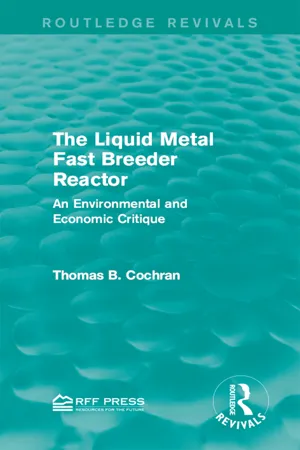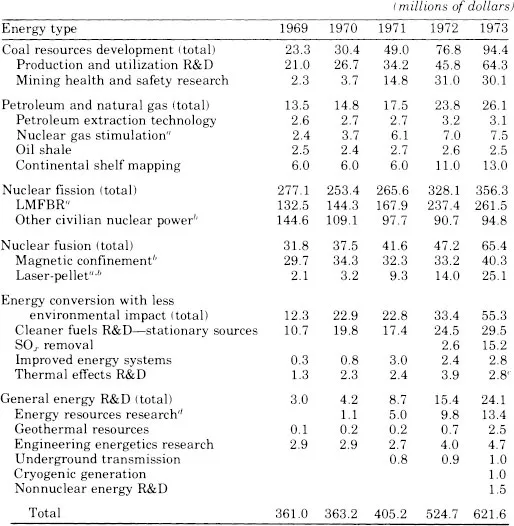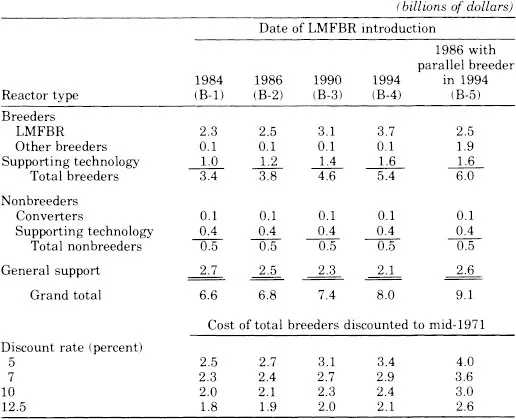
eBook - ePub
The Liquid Metal Fast Breeder Reactor
An Environmental and Economic Critique
Thomas B. Cochran
This is a test
- 272 pages
- English
- ePUB (mobile friendly)
- Available on iOS & Android
eBook - ePub
The Liquid Metal Fast Breeder Reactor
An Environmental and Economic Critique
Thomas B. Cochran
Book details
Book preview
Table of contents
Citations
About This Book
In this book, Thomas B. Cochran takes a critical look at the economic and environmental arguments which have been made in favour of an early introduction of the liquid metal fast breeder reactor (LMFBR) as a central component of the United States electrical energy system. First published in 1974, Cochran presents LMFBR as having no environmental advantage over light water reactors and the high temperature gas reactor and seriously questions the economic advantages. This title should be a useful for students interested in environment and sustainability studies, and it is a valuable resource for discussions of future energy strategy.
Frequently asked questions
At the moment all of our mobile-responsive ePub books are available to download via the app. Most of our PDFs are also available to download and we're working on making the final remaining ones downloadable now. Learn more here.
Both plans give you full access to the library and all of Perlego’s features. The only differences are the price and subscription period: With the annual plan you’ll save around 30% compared to 12 months on the monthly plan.
We are an online textbook subscription service, where you can get access to an entire online library for less than the price of a single book per month. With over 1 million books across 1000+ topics, we’ve got you covered! Learn more here.
Look out for the read-aloud symbol on your next book to see if you can listen to it. The read-aloud tool reads text aloud for you, highlighting the text as it is being read. You can pause it, speed it up and slow it down. Learn more here.
Yes, you can access The Liquid Metal Fast Breeder Reactor by Thomas B. Cochran in PDF and/or ePUB format, as well as other popular books in Ciencias biológicas & Ecología. We have over one million books available in our catalogue for you to explore.
Information
I
Economic Considerations
Introduction to Part I
LMFBR PROGRAM EXPENDITURES: ACTUAL AND ESTIMATED
According to official sources, federal expenditures on the LMFBR from 1969 through 1972 totaled $682 million (see Table 1). This includes expenditures for research and development, as well as operating, equipment, and construction costs; it does not include costs of research on environmental and health hazards from low-dose radiation exposure. During these four years, the proportion of federal R&D energy expenditures attributable to the LMFBR increased from 37 percent to 45 percent. However, according to one estimate, the actual resources committed may have been much higher because many of the AEC’s general reactor technology and safety programs have been diverted to solving problems specific to the breeder.1
In Table 1, federal expenditures for the LMFBR program are compared with other federal energy R&D funding during the 1969-73 fiscal-year period. As the table shows, federal energy R&D expenditures for fiscal 1973 will be about $622 million. About $260 million of this (42 percent) is allocated to the LMFBR program; $95 million (15 percent) to all other civilian nuclear power programs; $94 million (about 15 percent) to coal, one-third of which is for health and safety research; $65 million (10 percent) to fusion energy; and $26 million (4 percent) to petroleum and natural gas. Some $4 to $5 million—less than 1 percent—is being spent for solar energy research with terrestrial applications.’2
TABLE 1. Federal Energy Research and Development Funding, Fiscal Year 1969 Through 1973

SOURCE: Edward E. David (then director of the Office of Science and Technology), in Liquid Metal Fast Breeder Reactor (LMFBR) Demonstration Plant, Hearings before the U.S. Congress, Joint Committee on Atomic Energy, 92 Cong. 2 sess. (Sept. 7, 8, 12, 1972), pp. 164-65.
NOTE: The funding listed in these tables covers the federal R&D programs in development exploration and production, conversion, and transmission of our energy resources. This funding includes energy conversion R&D for stationary applications only; R&D funding for improved mobile applications (e.g., automotive, rail, seagoing) are not included. Fundamental research on environmental health effects of combustion products and low-dose radiation exposure is not included.
aThis funding includes operation, equipment, and construction costs.
bThe primary applications of the multipurpose laser-pellet effort are for other than energy production.
cThis entry includes $1,500,000 for dry cooling tower R&D under the AEC’s new nonnuclear energy R&D category. Other related work is carried out under other civilian nuclear power.
dThe NSF RANN program includes research on solar energy as well as fundamental energy policy studies.
The AEC and the Office of Management and Budget (OMB) break down the total LMFBR program expenditures for fiscal 1972 and 1973 as follows:3

The operating budget includes the LMFBR base ($122 million for 1972 and $132 million for 1973), the LMFBR portion of the general reactor technology budget (about 75 percent), the fast reactor safety budget ($14.5 million for 1972 and $19.7 million for 1973), and the LMFBR demonstration plant budget ($1.8 million for 1972 and $8 million for 1973).
The Memorandum of Understanding (discussed earlier) estimates the total demonstration plant project cost, including 30 percent escalation, as $700 million.4 Privately and publicly owned U.S. electric utilities have pledged, through the Breeder Reactor Corporation, approximately $250 million toward the plant’s financing. In addition, an estimated $4 million in administrative costs will be incurred by TVA and Commonwealth Edison for which the two utilities will not be reimbursed.
Through the AEC, the government has already authorized about $100 million toward the project. Eight million dollars of this has already been spent for design studies. The remaining $92 million is available for actual construction costs. Under the Memorandum of Understanding, the AEC is obligated to put up the additional $350 million in estimated costs plus any cost overruns. The AEC will assume all costs of decommissioning the plant unless TV A decides to buy the plant, a decision TV A does not have to make until five years after completion of operational testing, which TV A will conduct.
FIGURE 1. Anticipated LMFBR Program Expenditures

SOURCE: Part (a): AEC Authorizing Legislation—Fiscal Year 1974, Hearings before the Joint Committee on Atomic Energy, 93 Cong., 1 sess. (1973), p. 1760. Part (b): AEC Authorizing Legislation—Fiscal Year 1972, Hearings before the Joint Committee on Atomic Energy, 92 Cong., 1 sess. (1971), p. 96.
The Administration’s fiscal 1974 budget includes $772 million for energy-related R&D, of which $323 million (42 percent) is for the LMFBR program. Robert Gillette, whose breakdown of budget categories and budget figures differs slightly from those of E. E. David in Table 1, estimates that the LMFBR 1974 budget is up $50 million from 1973.5
At the request of the Administration, the AEC has prepared a study detailing where an additional $100 million on energy R&D will be spent in fiscal 1974.6 Half of this will go to coal, $7.3 million to geothermal, and $3.5 million to solar energy. Only $6.5 million of these additional funds will be spent on nuclear R&D, and all of this is to go to the gas-cooled reactor programs.
Projected budget requests for the LMFBR program were presented by Milton Shaw in hearings before the Joint Committee on Atomic Energy. Figure 1(a) shows the estimated annual costs for the LMFBR program through 1977. Figure 1(b) shows the anticipated cumulative governmental and utility expenditures through 1986 and 1984, respectively.
An AEC summary of estimated civilian nuclear power R&D costs, which appears to have been prepared about the same time, is presented in the Updated (1970) Cost-Benefit Analysis of the U.S. Breeder Reactor Program7 (referred to in this report as the 1970 Analysis). These data are reproduced in Table 2.
Comparing the estimates from the 1974 hearings and those in the 1970 Analysis with the budget estimates by David (shown in Table 1), several observations can be made. First, the estimated costs for fiscal 1970-73 in Figure 1(a) are lower than the LMFBR program expenditures in Table 1. This is because the term “LMFBR Program” in Figure 1(a) describes a budget category and does not include LMFBR-related costs in other budget categories, e.g., “Nuclear Safety” and “General Reactor Technology.” To this extent, then, the estimates embodied in Figure 1(a) are understated.
TABLE 2. Summary of Estimated AEC Cumulative Research and Development Costs, Mid-1971 to 2020

SOURCE: U.S. Atomic Energy Commission, Division of Reactor Development and Technology, Updated (1970) Cost-Benefit Analysis of the U.S. Breeder Reactor Program, WASH 1184 (Jan. 1972), pp. 10-11.
NOTE:
LMFBR commercially introduced in:* | ||
B-1 | Accelerated breeder program | 1984 |
B-2 | Currently planned breeder program | 1986 |
B-3 | Four-year delay in breeder development program | 1990 |
B-4 | Eight-year delay in breeder development program | 1994 |
B-5 | PBR program with parallel breeder introduced in 1994 | 1986 |
*Commercial introduction is defined as the date when a significant number of commercial-size LMFBR power plants become operational.
According to the 1970 AEC estimate reproduced in Table 2, the U.S. breeder program was to eventually cost (from mid-1971) an additional $3.4 billion to $6.0 billion in federal funds alone, and, as seen from Figure 1(b), may influence the way in which the utility companies will spend billions more per year on energy systems by the end of the century. However, the projected LMFBR program expenditures in Table 2 (up to $6.0 billion) are understated to the extent that a major share of the funding in the “General Support” category is also directed toward support of the LMFBR program. In October 1973, it was reported the AEC’s unofficial estimate of LMFBR costs was $5.1.8 This estimate (in 1973 dollars) covers the fourteen-year period 1974 to 1988, and, as reported, includes $1 billion for “general” R&D that would indirectly benefit the LMFBR and $90 million that would be spent in direct assistance to utilities to help them buy their first four commercial-size breeder power plants.9
It is not clear whether the $2.4 billion, labeled in Figure 1(b) as the cumulative governmental expenditures between 1970 and 1986, is consistent with the data presented in Table 2. If, for example, it is the same as the estimated total breeder expenditures discounted at 7 percent in Table 2, then the values for the discounted cost of the breeder program, which were used to calculate net benefits and benefit-to-cost ratios in the 1970 Analysis represent expenditures through 1986 (or the appropriate LMFBR market entry date) and exclude further expenditures, such as the light-water reactor (LWR) program is incurring today (e.g., Power Burst Facility, Loss of Fluid Test Facility, etc.). In any case, it is clear that the net benefits and benefit-to-cost ratios in the 1970 Analysis exclude the nonfederal breeder R&D costs provided by the nuclear industry.
The total utility commitment through 1984 is estimated in Figure 1(b). While it is unclear how much of this represents capital equipment and other expenditures that should not be included as R&D costs, it does suggest that if nonfederal R&D costs were included in the 1970 Analysis, the net benefits and benefit-to-cost ratios would be considerably lower.
Based on past experience with nuclear reactor programs, the LMFBR program is likely to continue to experience considerable cost overruns. Paul MacAvoy, reporting on the ratio of realized-to-forecast cons...
Table of contents
- Cover
- Half Title
- Title Page
- Copyright Page
- Original Copyright
- Table of Contents
- PREFACE
- ACKNOWLEDGMENTS
- INTRODUCTION
- PART I Economic Considerations
- PART II Environmental Considerations
- PART III Summary and Conclusions